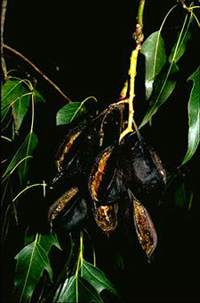Common name:
Black Kurrajong Tree, Kurrajong
Family name:
Sterculiaceae
Botanical name:
Brachychiton populneus
Flowering/fruiting season:
'seeds available summer - autumn' (Flood, 1980:96)
Location:
On rocky slopes and low hills below 2500' [760m] (Burbidge & Gray, 1976:25)
Use:
- Food, technology
- Young roots eaten and seeds (hard but can be crushed) (Flood, 1980:96)
- Seed ground, made into cakes, cooked; wood for shield (Parker in Gott, 1995)
- Young roots and shoots eaten, 'sweetish and agreeable taste.' (Bennett in Flood, 1980:296)
- 'Bark … source of fibre … for making nets, headbands and fishing lines.' (Zola & Gott, 1992:36)

Notes:
- The name 'kurrajong' was given to fibre from bark of various plants that was used for making nets, fishing lines, headbands in the Sydney area (Gott, 1995)
- Leichhardt found that the seeds of B. populneus 'produced not only a good beveridge with an agreeable flavour, but ate well and appeared to be very nourishing' (Cribb & Cribb, 1987:94)
- 'Kurrajong seeds in their tough, woody pods are highly nutritious.' (Zola & Gott, 1992:36)
- Warning:'Minute hairs around seeds are liable to cause irritation.' (Burbidge & Gray, 1976:256)